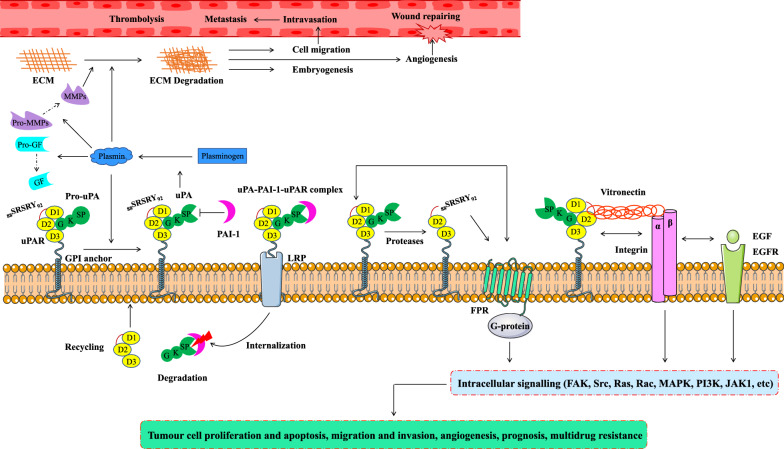Fig. 1.
Schematic representation of the uPAR-mediated pathways. The GPI-anchored receptor uPAR consisting of D1, D2, and D3 domains binds the zymogen pro-uPA and the active uPA through the GF domain. The active form of uPA then converts plasminogen into plasmin, which subsequently cleaves and activates GFs, and MMPs, leading to the degradation of ECM in important physiological processes and in pathological processes associated with cancer development. PAI-1 inhibits the catalytic activity of both uPA and plasmin. Internalization and recycling of uPAR occur after a uPA-PAI-1-uPAR complex has formed, resulting in the degradation of uPA-PAI-1 and the recycling of uPAR to the cell surface. uPAR is cleaved between the D1 and D2 domains, exposing the 88SRSRY92 sequence at its N-terminus to interact with FPR of the GPCRs, promoting its internalization and activating signalling. In addition to uPA, uPAR interacts with Vn, integrins and other cell surface receptors, such as EGFRs, to activate different intracellular signalling pathways [FAK, Src, Ras, Rac, MAPK, PI3K, JAK1, etc.] and regulate tumour cell proliferation and apoptosis, migration and invasion, angiogenesis, prognosis and multidrug resistance. uPAR urokinase-type plasminogen activator receptor, uPA urokinase plasminogen activator, GPI glycosylphosphatidylinositol, GF growth factor, MMPs matrix metalloproteinases, ECM extracellular matrix, PAI-1 plasminogen activator inhibitor-1, Vn vitronectin, EGFR epidermal growth factor receptor, LRP low-density lipoprotein receptor-related protein, GPCRs G-protein coupled receptors, FPR formyl peptide receptor, FAK focal adhesion kinase, Src tyrosine-protein kinase, MAPK mitogen activated protein kinase, Rac Ras-related C3 botulinum toxin substrate, PI3K phosphatidylinositol 3-kinase, JAK1 janus kinase 1

